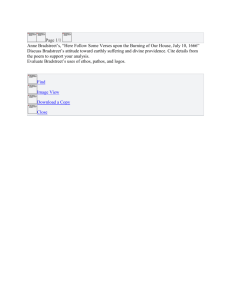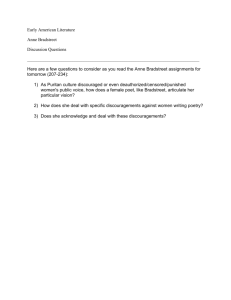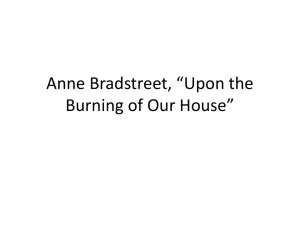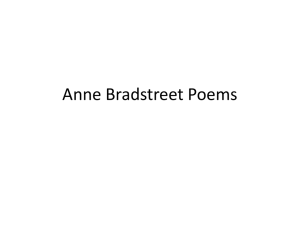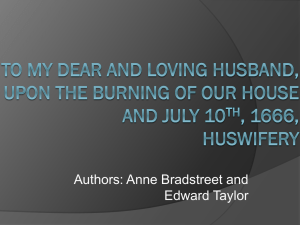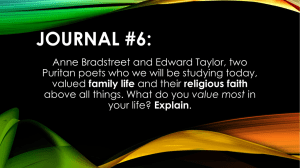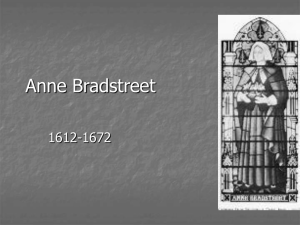2327.RG.Bradstreet.doc
advertisement
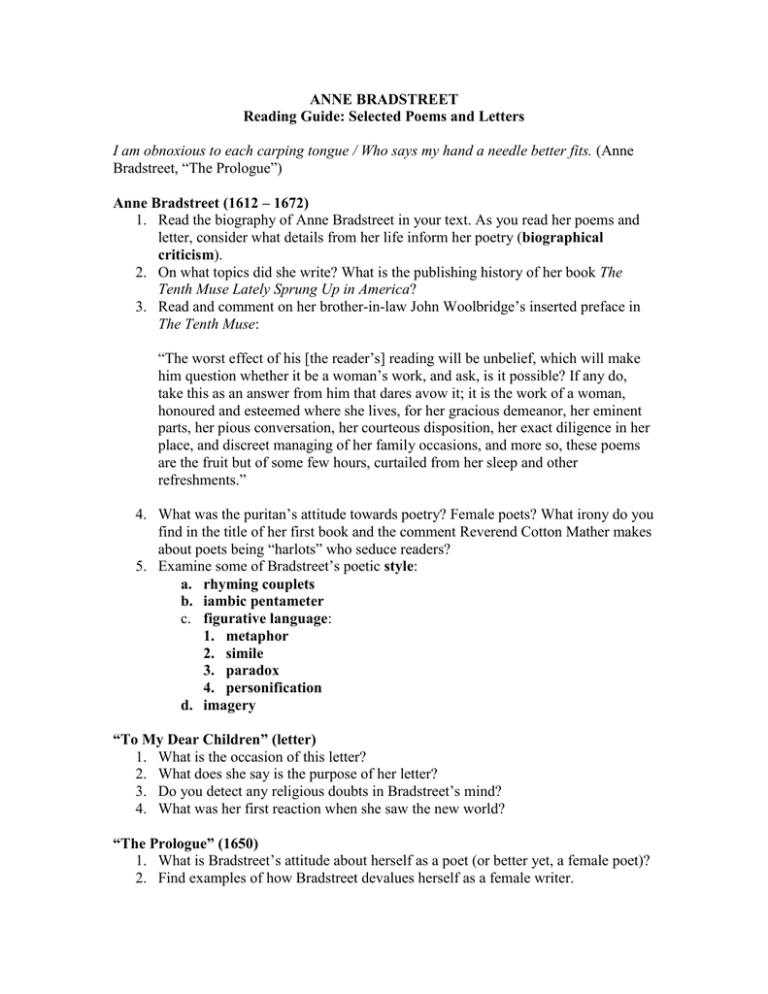
ANNE BRADSTREET Reading Guide: Selected Poems and Letters I am obnoxious to each carping tongue / Who says my hand a needle better fits. (Anne Bradstreet, “The Prologue”) Anne Bradstreet (1612 – 1672) 1. Read the biography of Anne Bradstreet in your text. As you read her poems and letter, consider what details from her life inform her poetry (biographical criticism). 2. On what topics did she write? What is the publishing history of her book The Tenth Muse Lately Sprung Up in America? 3. Read and comment on her brother-in-law John Woolbridge’s inserted preface in The Tenth Muse: “The worst effect of his [the reader’s] reading will be unbelief, which will make him question whether it be a woman’s work, and ask, is it possible? If any do, take this as an answer from him that dares avow it; it is the work of a woman, honoured and esteemed where she lives, for her gracious demeanor, her eminent parts, her pious conversation, her courteous disposition, her exact diligence in her place, and discreet managing of her family occasions, and more so, these poems are the fruit but of some few hours, curtailed from her sleep and other refreshments.” 4. What was the puritan’s attitude towards poetry? Female poets? What irony do you find in the title of her first book and the comment Reverend Cotton Mather makes about poets being “harlots” who seduce readers? 5. Examine some of Bradstreet’s poetic style: a. rhyming couplets b. iambic pentameter c. figurative language: 1. metaphor 2. simile 3. paradox 4. personification d. imagery “To My Dear Children” (letter) 1. What is the occasion of this letter? 2. What does she say is the purpose of her letter? 3. Do you detect any religious doubts in Bradstreet’s mind? 4. What was her first reaction when she saw the new world? “The Prologue” (1650) 1. What is Bradstreet’s attitude about herself as a poet (or better yet, a female poet)? 2. Find examples of how Bradstreet devalues herself as a female writer. 3. Why would she devalue herself? Is she wearing a mask? If so, for what possible purposes? 4. Make a stanza by stanza explication of this poem. “The Author to Her Book” (1666, published 1678) NOTE: Bradstreet wrote this poem after she witnessed the shabby production of her first book. In the poem she speaks to the book as if it were her bastard child. 1. Why did Bradstreet write “The Author to Her Book”? 2. What is the controlling metaphor of the poem? 3. How does she use personification? 4. Note the poetic devices used in the poem. 5. What is the tone of the poem? 6. Once again, find examples of how Bradstreet “devalues” her abilities? “To My Dear and Loving Husband” (published 1678) 1. This poem is a lyric. Define this term. 2. Note the imagery Bradstreet used is the imagery religious or secular? 3. Note poetic devices: paradox, iambic pentameter, and couplet. “In Memory of My Dear Grandchild Anne Bradstreet” 1. What compensation does Bradstreet find in the death of her grandchild? 2. Note poetic devices. “Upon the Burning of Our House in 1666” 1. What statement does Bradstreet make on the value of worldly goods? 2. Do you detect any faltering of her faith in this poem? 3. What consolation does she seek? CRITICAL THINKING 1. Define feminist criticism. What are some of the aims of feminist critics? Apply feminist criticism to Anne Bradstreet. 2. Is Bradstreet’s modest tone a pose to protect herself?
